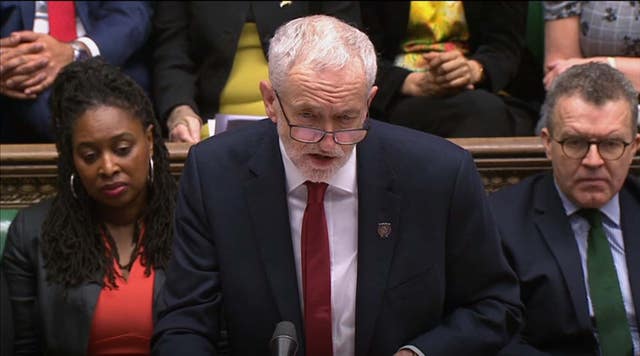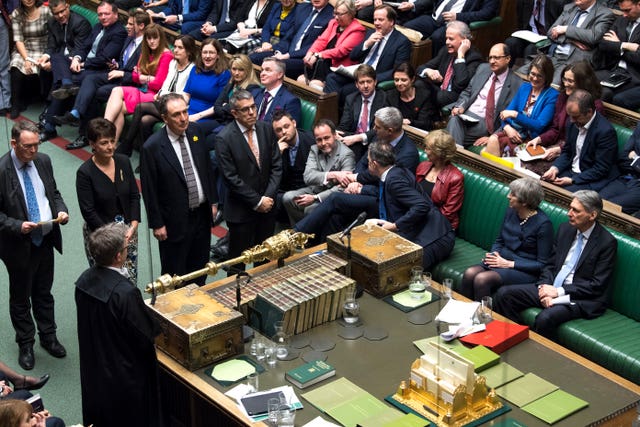All the talk in Westminster is about indicative votes on Brexit.
But what are they, and how would they work?
READ MORE: MPs seize control of Brexit as Theresa May left humiliated
– What is an indicative vote?
An indicative vote is an opportunity for MPs to vote on a series of options in a particular situation to establish whether any of them can command a majority in the House of Commons. As an expression of the House’s will, it is not necessarily binding on the Government.
– Who has proposed it?
A cross-party group of MPs, led by Conservative former ministers Sir Oliver Letwin and Dominic Grieve and Labour’s Hilary Benn, used a vote on Monday evening to seize control of the parliamentary agenda on Wednesday so a series of votes can be held then.
 Election 2015 aftermath – May 11th">Sir Oliver Letwin (Dominic Lipinski/PA)
Election 2015 aftermath – May 11th">Sir Oliver Letwin (Dominic Lipinski/PA)
– Who is backing it?
The Letwin amendment was agreed by 329 votes to 301, a majority of 27, with three ministers resigning from the Government to support it – Richard Harrington, Alistair Burt and Steve Brine. Jeremy Corbyn and most Labour MPs voted for it.
 Jeremy Corbyn (House of Commons/PA)
Jeremy Corbyn (House of Commons/PA)
– Why did the Prime Minister oppose it?
Theresa May warned that allowing Parliament to take control of the Commons agenda, which is normally determined by the Government, would set an “unwelcome” constitutional precedent. If MPs had rejected the Letwin plan, she had promised to provide Government time for a similar procedure led by ministers. But she said she was “sceptical” about the process and would not be bound by its outcome, which she warned could produce “contradictory outcomes or no outcome at all”.
– What might MPs vote on?
There is no list of options yet, but they could include the Prime Minister’s deal; no deal; a Canada-style free trade agreement; Labour’s plan for a customs union and close alignment with the single market; the so-called Common Market 2.0 proposals; a Norway-style close partnership with the EU; revoking Article 50 to maintain EU membership; or a referendum on any of these possible outcomes.
– And which is most likely to win?
So far, Mrs May has secured no more than 242 out of a possible 650 votes for her deal, and she admitted on Monday she cannot guarantee a majority for it. A “softer” Brexit involving participation in the customs union or single market may come closer to commanding the support of more than half of MPs, but it is not thought likely that either no deal or no Brexit would come out on top.
 MPs have rejected a number of Brexit options in votes in the Commons (UK Parliament/Mark Duffy/PA)
MPs have rejected a number of Brexit options in votes in the Commons (UK Parliament/Mark Duffy/PA)
– Is there certain to be a winning option?
This would depend on the voting system. If MPs were asked to vote Aye or No on each proposal in turn, there is every possibility that all of them would be rejected. However, Mrs May’s effective deputy David Lidington is understood to have floated the possibility of using a different system which would guarantee a result. This could involve an alternative vote, under which MPs would number options in order of preference, with votes redistributed as the least popular are eliminated, or exhaustive votes, with MPs taking part in a series of rounds of voting as defeated options are removed one-by-one from the list.
– Has this ever been done before?
It is a very rare parliamentary procedure. In 2003, MPs voted on seven options for reform of the House of Lords and rejected every one of them, with the result that proposals for a partially or fully elected second chamber ran into the sand and have never been revived.
– Why haven’t MPs voted on these things yet?
The only real opportunities to vote on alternative Brexit options in the Commons have come in amendments to Mrs May’s “meaningful votes” on her Withdrawal Agreement and motions following its defeat. This process has seen MPs reject options including a no-deal Brexit, a second referendum, the Labour plan and the revocation of Article 50. However, in a tribal Commons, many MPs are reluctant to back a proposal tabled by their opponents. It is far from certain the results would be repeated in an indicative vote.
READ MORE: Nicola Sturgeon: Theresa May already 'out of power'



Why are you making commenting on The Herald only available to subscribers?
It should have been a safe space for informed debate, somewhere for readers to discuss issues around the biggest stories of the day, but all too often the below the line comments on most websites have become bogged down by off-topic discussions and abuse.
heraldscotland.com is tackling this problem by allowing only subscribers to comment.
We are doing this to improve the experience for our loyal readers and we believe it will reduce the ability of trolls and troublemakers, who occasionally find their way onto our site, to abuse our journalists and readers. We also hope it will help the comments section fulfil its promise as a part of Scotland's conversation with itself.
We are lucky at The Herald. We are read by an informed, educated readership who can add their knowledge and insights to our stories.
That is invaluable.
We are making the subscriber-only change to support our valued readers, who tell us they don't want the site cluttered up with irrelevant comments, untruths and abuse.
In the past, the journalist’s job was to collect and distribute information to the audience. Technology means that readers can shape a discussion. We look forward to hearing from you on heraldscotland.com
Comments & Moderation
Readers’ comments: You are personally liable for the content of any comments you upload to this website, so please act responsibly. We do not pre-moderate or monitor readers’ comments appearing on our websites, but we do post-moderate in response to complaints we receive or otherwise when a potential problem comes to our attention. You can make a complaint by using the ‘report this post’ link . We may then apply our discretion under the user terms to amend or delete comments.
Post moderation is undertaken full-time 9am-6pm on weekdays, and on a part-time basis outwith those hours.
Read the rules hereLast Updated:
Report this comment Cancel